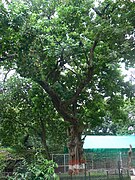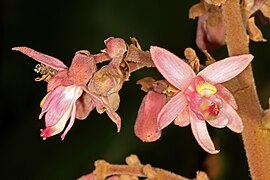Kleinhovia
| Kleinhovia | |
|---|---|

| |
| Foliage and fruit in Kolkata, West Bengal, India | |
| Scientific classification | |
| Kingdom: | Plantae |
| Clade: | Tracheophytes |
| Clade: | Angiosperms |
| Clade: | Eudicots |
| Clade: | Rosids |
| Order: | Malvales |
| Family: | Malvaceae |
| Subfamily: | Byttnerioideae |
| Tribe: | Byttnerieae
|
| Genus: | Kleinhovia L.[3] |
| Species: | K. hospita
|
| Binomial name | |
| Kleinhovia hospita | |
| Synonyms | |
|
See text | |
Kleinhovia is a monotypic genus of plants in the cotton, hibiscus and cacao family Malvaceae. The sole species in the genus is Kleinhovia hospita, commonly known as guest tree, an evergreen tree native to Indonesia, Malaysia and other parts of tropical Asia and the Pacific.
Description
This section may be too technical for most readers to understand. (April 2024) |
This section needs additional citations for verification. (April 2024) |
Kleinhovia hospita is an evergreen, bushy tree growing up to 20 m (66 ft) high, with a dense rounded crown and upright pink sprays of flowers and fruits. Leaves are simple and alternate;
The flowers of K. hospita are terminal, in loose
Fruit production starts early, often in the third year after planting. The fruit of K. hospita are rounded, 5-lobed, thin-walled, membranous capsules, 2.5 cm (0.98 in) in diameter, loculicidally dehiscent, each locule having 1–2 seeds. The seeds are globose, whitish, warty and exalbuminous.[4] The fruits are more conspicuous than the flowers because of their abundance and size.
Range
Kleinhovia's range includes Bangladesh, Christmas Island, Peninsular Malaysia, Vietnam, Hainan, Taiwan, the Ryukyu Islands, Caroline Islands, Lesser Sunda Islands, Solomon Islands, Vanuatu, Fiji, Tonga, Samoan Islands, and Society Islands.[2]
It has been introduced to the Comoro Islands, Pakistan, Puerto Rico, Sri Lanka, Thailand, Trinidad and Tobago, and the Windward Islands.[2]
Uses
Kleinhovia hospita is used as a traditional medicine in parts of Peninsular Malaysia, Indonesia and
The wood of K. hospita shows a pinkish buff and is moderately fine in texture, soft, light, easy to season, work and finish. Its energy value is about 19000
Kleinhovia hospita is used for ornamental purposes: the attractiveness of the pink panicles accounts for its spread as an ornamental.
The tree bark of Kleinhovia hospita has a good potential as a reinforcement for Fiber Reinforced Composite because of its high mechanical strength.[7]
Gallery
-
Mature tree
-
Foliage
-
Colour plate byFrancisco Manuel Blanco
-
Budding inflorescence
-
Close up of flowers
-
Pollen grains
-
Flowers and fruit
References
- doi:10.2305/IUCN.UK.2019-2.RLTS.T147651836A147651838.en. Retrieved 10 April 2024.)
{{cite journal}}: CS1 maint: multiple names: authors list (link - ^ a b c "Kleinhovia hospita L." Plants of the World Online. Royal Botanic Gardens, Kew. 2024. Retrieved 10 April 2024.
- ^ "Kleinhovia L." Plants of the World Online. Royal Botanic Gardens, Kew. 2024. Retrieved 10 April 2024.
- ^ Lattiff, pp 166–167
- ^ Stuart, Godofredo. "Tan-ag, Kleinhovia hospita Linn., GUEST TREE". Stuart Exchange. G. Stuart. Retrieved 1 January 2010.
- ^ Latiff, A. (1997). Faridah Hanum, I.; van der Maesen, L.J.G. (eds.). Plant Resources of South-East Asia. Vol. 11. Bogor, Indonesia: PROSEA Foundation. Retrieved 10 April 2024.
- ^
Gapsari, Femiana; Purnowidodo, Anindito; Hidayatullah, Syarif; Suteja, Suteja (10 June 2021). "Characterization of Timoho Fiber as a reinforcement in green composite". Journal of Materials Research and Technology. 13: 1305–1315. S2CID 236312528.
External links
- View images of this species on Flickriver.com
- View observations of this species on iNaturalist








